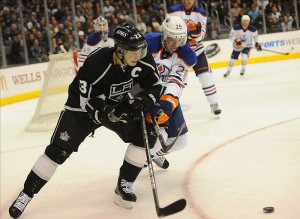With the relatively brief 5-game dismissal of the 2011-2012 Vancouver Canucks by the Los Angeles Kings this past Sunday, an interesting trend in the post-lockout NHL has continued. Vancouver became the third regular season champion ousted in the first round of the playoffs in the last four years. Of the seven Presidents’ Trophy winners during this era, only the 2007-2008 Detroit Red Wings converted their regular season success into playoff glory by eventually capturing the Stanley Cup. This is a somewhat remarkable accomplishment, especially when considering that Detroit team was also one of only three post-lockout Presidents’ Trophy champions to move into the second round of the playoffs.

When statistically breaking down the post-lockout regular season champions, four of those seven teams have lost in the first round to #8 seeds: the 2005-2006 Red Wings (124 points) to the Edmonton Oilers (95 points), the 2008-2009 San Jose Sharks (117 points) to the Anaheim Ducks (91 points), the 2009-2010 Washington Capitals (121 points) to the Montreal Canadiens (88 points), and as previously mentioned the Canucks (111 points) to the Kings (95 points) this year. Overall, the best team in the regular season for the last seven seasons has been defeated in the first round 57% of the time.
This recent stretch serves as a considerable departure from the pre-lockout NHL, particularly since the NHL shifted to its current playoff format in 1994. In those 11 years (until the lockout season of 2004-2005), the Presidents’ Trophy winner was bounced in the first round only once. That particular indignation belongs to the 1999-2000 St. Louis Blues (114 points) as they lost out to the San Jose Sharks (87 points). During this stretch the Presidents’ Trophy Winner won the Stanley Cup four times (93-94 New York Rangers, 98-99 Dallas Stars, 00-01 Colorado Avalanche, 01-02 Red Wings), lost in the Conference Finals four times (95-96 Red Wings, 96-97 Avalanche, 97-98 Stars; 02-03 Ottawa Senators); lost in the Stanley Cup Finals once (94-95 Red Wings), and lost in the second round once (03-04 Red Wings). In summation, 91% of the Presidents’ Trophy winners of this era made it past the first round and either made it to the Conference Finals or won the Stanley Cup 73% of the time. If we include the runner-up Red Wings in 94-95, the Presidents’ Trophy winners in the 11 years preceding the lockout either made the Conference Finals, Stanley Cup Finals, or won the Stanley Cup a whopping 82% of the time.
This is a remarkable figure when considering that only two Presidents’ Trophy teams have made it to the Cup Finals since the lockout, the aforementioned 07-08 Stanley Cup Champion Red Wings and the 2010-2011 Vancouver Canucks, who lost the Cup to the Boston Bruins in 7 games. This recent trend goes to show the remarkable parity in today’s NHL that is simply unrivaled by the other 3 major professional sports leagues in North America (National Football League, National Basketball League, Major League Baseball). This evidence also essentially substantiates that, although admittedly flawed in many ways, the salary cap has somewhat succeeded in terms of equalizing the playing field since the first post-lockout season of 2005-2006. The President’s Trophy winners (aka top-spending teams) are no longer guaranteed a relatively inferior opponent in the first round that did not have a chance statistically or economically.
The most recent victim of the Presidents’ Trophy curse, the Canucks, fell to an 8th seeded Kings squad that was just two points shy of winning their own division. The 08-09 Sharks fells to a Ducks team that was two years removed from a Stanley Cup title. The 05-06 Red Wings fell to an upstart Oilers team that went all the way to Game 7 of the finals. The 09-10 Habs followed up their shocking defeat of the Capitals by beating the heavily favoured Pittsburgh Penguins in the next round on the back of Jaroslav Halak’s strong goaltending and stingy defense.
While the numbers may still even out once the post-lockout era concludes its 11th season and allows for a closer comparison, the recent pattern definitely suggests that a regular season championship banner will mostly serve to remind fans of a year of wasted potential.